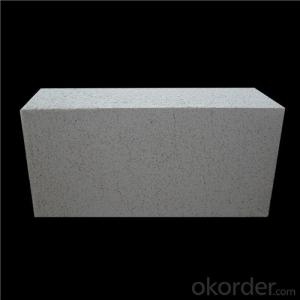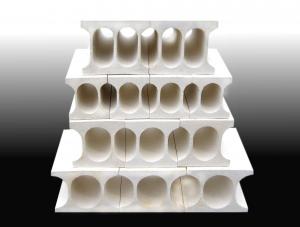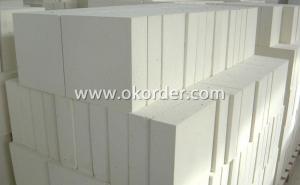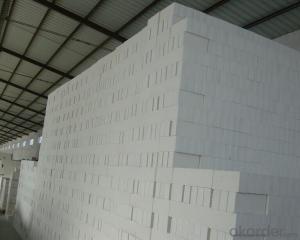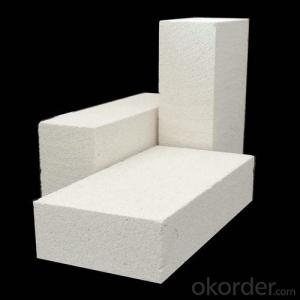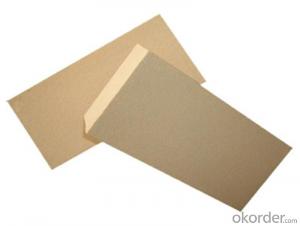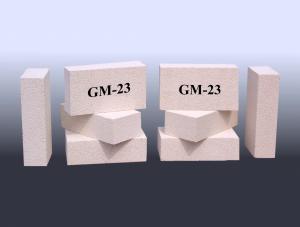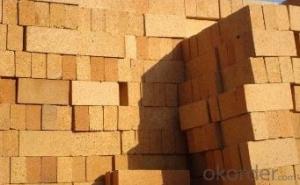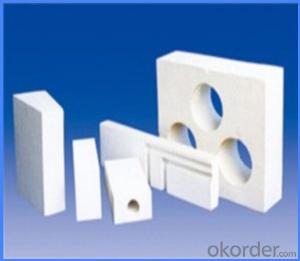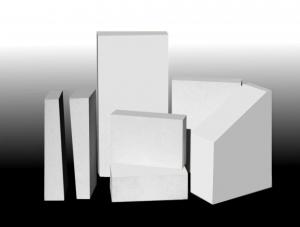Insulating Fire Brick GJM26 - High Quality Insulation for Fire Safety
- Loading Port:
- China Main Port
- Payment Terms:
- TT OR LC
- Min Order Qty:
- -
- Supply Capability:
- -
OKorder Service Pledge
Quality Product, Order Online Tracking, Timely Delivery
OKorder Financial Service
Credit Rating, Credit Services, Credit Purchasing
You Might Also Like
General Information
CMAX insulating firebricks are classified under temperature between 1300℃ to 1700℃, manufactured from high purity alumina clay.
Feature
Light weight and low thermal conductivity
Low heat storage
Low iron and impurities
High thermal shock resistance
Application
CMAX insulating firebricks can be used as a hot face lining directly exposed to the heat or as a backup insulation layer in iron and steel mills, non-ferrous foundries, petrochemical, ceramic, glass.
- Q: Can insulating fire bricks be used in the construction of lime recovery kilns?
- Yes, insulating fire bricks can be used in the construction of lime recovery kilns. These bricks are designed to withstand high temperatures and provide excellent thermal insulation, making them suitable for such applications. They help to conserve energy and maintain the desired temperature within the kiln, enhancing the efficiency of the lime recovery process.
- Q: Can insulating fire bricks be used in outdoor fire pits?
- Yes, insulating fire bricks can be used in outdoor fire pits. Insulating fire bricks are designed to withstand high temperatures, making them suitable for use in fire pits. They are made from materials that are resistant to heat, such as ceramic fibers or refractory materials, which helps to retain the heat within the fire pit. Additionally, insulating fire bricks are lightweight and easy to install, making them a convenient choice for outdoor fire pits. However, it is important to note that insulating fire bricks may not be as durable as regular fire bricks, so they may require more frequent replacement if exposed to extreme temperatures or harsh weather conditions.
- Q: Can insulating fire bricks be used in the construction of tundishes?
- Yes, insulating fire bricks can be used in the construction of tundishes. Tundishes are commonly used in the steel industry to distribute molten metal, and insulating fire bricks are ideal for this purpose as they have excellent thermal insulation properties and can withstand high temperatures.
- Q: Can insulating fire bricks be used in chimneys and flues?
- Insulating fire bricks are specifically designed for high-temperature applications and are often used in furnaces, kilns, and other industrial settings. While they do possess excellent insulating properties, they may not be the best choice for chimneys and flues in residential or commercial buildings. The main reason for this is that insulating fire bricks are not as durable and heat-resistant as other materials specifically designed for chimney and flue construction. They may crack or break when exposed to the extreme heat and rapid temperature changes that occur in chimneys. Additionally, these bricks are not typically designed to withstand the corrosive effects of flue gases, which can lead to their degradation over time. When it comes to chimneys and flues, it is generally recommended to use materials such as clay flue liners, stainless steel, or refractory bricks that are specifically manufactured for these applications. These materials are better suited to handle the high temperatures, corrosive gases, and rapid thermal expansion and contraction that occur in chimneys. It is important to consult with a professional chimney or flue specialist who can advise on the appropriate materials to use based on the specific requirements and conditions of your chimney or flue system.
- Q: How do insulating fire bricks affect the overall sustainability of a structure?
- The overall sustainability of a structure is greatly enhanced by the use of insulating fire bricks. These bricks are designed to provide exceptional thermal insulation, resulting in reduced heat transfer and improved energy efficiency. Their ability to minimize heat loss or gain contributes to the sustainability of a structure in various ways. To begin with, insulating fire bricks play a crucial role in reducing energy consumption by maintaining a stable indoor temperature. Their excellent insulating properties prevent heat loss in the winter and heat gain in the summer, reducing the need for heating and cooling systems. As a result, energy consumption and the associated greenhouse gas emissions are lowered. In addition, the enhanced thermal insulation provided by insulating fire bricks leads to significant cost savings. Lower energy consumption translates into reduced utility bills, making the structure economically sustainable in the long term. Furthermore, the durability and longevity of these bricks mean that replacements or repairs are less frequent, further contributing to the economic sustainability of the structure. Moreover, insulating fire bricks improve occupant comfort, which is another aspect of a sustainable structure. With better insulation, the indoor temperature remains stable, creating a more comfortable living or working environment. This reduces the need for additional heating or cooling, ultimately enhancing the overall well-being and satisfaction of the occupants. Furthermore, insulating fire bricks have a positive impact on environmental sustainability. By reducing energy consumption, these bricks contribute to the conservation of natural resources and minimize the structure's carbon footprint. The decreased reliance on fossil fuel-based energy sources helps mitigate climate change and reduce air pollution. In conclusion, insulating fire bricks have a significant positive impact on the sustainability of a structure. They reduce energy consumption, improve energy efficiency, lower costs, enhance occupant comfort, and contribute to environmental sustainability. Therefore, incorporating insulating fire bricks in the design and construction of a structure is an effective way to promote sustainability and create a more environmentally friendly and economically viable building.
- Q: What are the advantages of using insulating fire bricks over other insulation materials?
- There are several advantages to using insulating fire bricks over other insulation materials. Firstly, insulating fire bricks have a high thermal conductivity, meaning they can effectively insulate against heat transfer. This makes them ideal for applications where heat containment is crucial, such as in furnaces, kilns, and industrial ovens. Their ability to withstand high temperatures and prevent heat loss makes them a reliable choice for insulation. Secondly, insulating fire bricks are highly durable and resistant to wear and tear. They are made from high-quality refractory materials, which are designed to withstand extreme conditions, including thermal shocks and chemical exposure. This durability ensures a longer lifespan and reduces the need for frequent replacements or repairs. Another advantage is their versatility. Insulating fire bricks come in various shapes and sizes, allowing for easy customization and installation in different applications. They can be easily cut or shaped to fit specific requirements, making them suitable for complex geometries or curved surfaces. This flexibility allows for efficient insulation in a wide range of settings. Moreover, insulating fire bricks have excellent insulation properties even at lower densities. This means that they can provide optimal thermal insulation while also reducing the overall weight of the structure. This is particularly advantageous in industries where weight reduction is critical, such as aerospace or automotive manufacturing. Lastly, insulating fire bricks are environmentally friendly. They are typically made from natural and recyclable materials, minimizing their impact on the environment. Additionally, their long lifespan and low maintenance requirements contribute to sustainability by reducing waste generation and energy consumption. In conclusion, the advantages of using insulating fire bricks over other insulation materials include high thermal conductivity, durability, versatility, lightweight, and environmental friendliness. These characteristics make them a preferred choice for insulation in various industries and applications.
- Q: What is the recommended curing method for insulating fire bricks?
- To prevent cracking or damage, it is advised to gradually and carefully air dry insulating fire bricks after they have been laid and mortared into place. It is crucial to maintain a stable temperature and humidity level throughout the curing process. This can be achieved by gradually increasing the temperature over a few days and ensuring proper ventilation. The bricks should be exposed to air circulation to aid in the evaporation of any moisture in the mortar or within the bricks themselves. It should be noted that the length of the curing process may vary depending on the size and thickness of the brickwork. Attempting to expedite the process by applying excessive heat or moisture can cause thermal stress and compromise the integrity of the bricks. In some instances, it may be advisable to pre-fire the bricks in a kiln to eliminate any remaining moisture before installation. This can help accelerate the curing process and guarantee that the bricks are completely dried before being put into service. In conclusion, the recommended curing method for insulating fire bricks involves gradual air drying, maintaining consistent temperature and humidity levels, and allowing sufficient time for the bricks to fully cure before exposing them to high temperatures. By adhering to these guidelines, the longevity and performance of the insulating fire bricks can be ensured.
- Q: Is the building built of cement hollow board safe?
- According to the use of building housing, before the use of cement hollow plate, it is necessary to predict the bearing capacity of housing, if more than the cement hollow plate bearing indicators, it is not available, it is unsafe;
- Q: How durable are insulating fire bricks?
- Insulating fire bricks are known for their exceptional durability and longevity. These bricks are made from high-quality refractory materials, such as alumina and silica, which possess excellent thermal resistance and mechanical strength. As a result, insulating fire bricks can withstand extreme temperatures ranging from 1300°C to 1800°C (2372°F to 3272°F) without losing their structural integrity. The durability of insulating fire bricks can be attributed to several key factors. Firstly, their low thermal conductivity allows them to effectively insulate heat and prevent thermal shock, which is crucial for ensuring their long-term durability. Additionally, the high melting point of the refractory materials used in their production contributes to their ability to withstand intense heat. Moreover, insulating fire bricks are resistant to chemical erosion and corrosion, making them suitable for various industrial applications. They can withstand exposure to harsh chemicals, acids, and alkalis, ensuring their durability even in demanding environments. Furthermore, insulating fire bricks have a low density, making them lightweight and less susceptible to cracking or breaking under pressure. This characteristic enhances their durability and ease of handling during installation or maintenance. Overall, insulating fire bricks are highly durable and can withstand extreme temperatures, thermal shock, chemical erosion, and mechanical stress. Their exceptional durability makes them a preferred choice for applications such as furnaces, kilns, ovens, and other high-temperature environments where thermal insulation and long-lasting performance are essential.
- Q: Can insulating fire bricks be used in the construction of coke ovens?
- The use of insulating fire bricks in the construction of coke ovens is indeed possible. These bricks are specifically designed to endure extreme temperatures and offer exceptional thermal insulation. Coke ovens, which typically operate at around 2000 degrees Fahrenheit, necessitate materials that can withstand such conditions. The low thermal conductivity of insulating fire bricks effectively hinders heat transfer between the interior and exterior of the oven. This feature helps to maintain the necessary high temperatures for coal carbonization in the coke oven, while simultaneously minimizing heat loss. Moreover, insulating fire bricks possess a lightweight composition and high strength, which makes them ideal for coke oven construction. Their lightweight nature facilitates easier installation and reduces the overall weight of the structure. Additionally, their high strength ensures that they can endure the harsh operating conditions of the coke oven without cracking or crumbling. In conclusion, insulating fire bricks are a suitable choice for constructing coke ovens due to their ability to withstand high temperatures, provide thermal insulation, and offer durability.
Send your message to us
Insulating Fire Brick GJM26 - High Quality Insulation for Fire Safety
- Loading Port:
- China Main Port
- Payment Terms:
- TT OR LC
- Min Order Qty:
- -
- Supply Capability:
- -
OKorder Service Pledge
Quality Product, Order Online Tracking, Timely Delivery
OKorder Financial Service
Credit Rating, Credit Services, Credit Purchasing
Similar products
Hot products
Hot Searches
Related keywords










